My Town: Ridgefield
Where is my town?
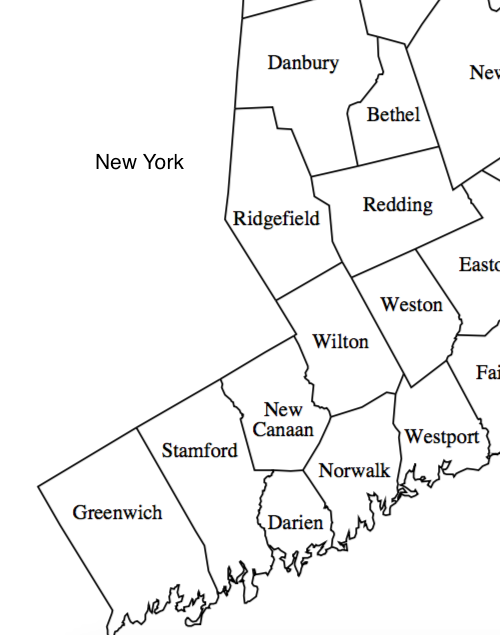 Ridgefield is in the southwest part of the state. It is bordered to the north and east by Danbury and Redding. Wilton is to the south. Its western border is the state border. New York State is to the west. Ridgefield is named for its rocky ridges. The highest point in town is 1,060 feet above sea level. There are mineral deposits and limestone was mined in town.
Ridgefield is in the southwest part of the state. It is bordered to the north and east by Danbury and Redding. Wilton is to the south. Its western border is the state border. New York State is to the west. Ridgefield is named for its rocky ridges. The highest point in town is 1,060 feet above sea level. There are mineral deposits and limestone was mined in town.
How was it founded?
Ridgefield was settled in 1708. It was incorporated the following year. Many of the settlers were from Norwalk and Milford. The settlers were looking for farmland. They bought 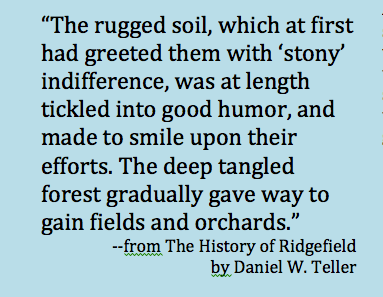 20,000 acres of land from Catoonah. Catoonah was sachem of the Ramapoo Indians.
20,000 acres of land from Catoonah. Catoonah was sachem of the Ramapoo Indians.
The settlers surveyed the land. They set out home lots for each settler. They also set aside common land for plowing, grazing, and mowing. They set aside land for a blacksmith. In 1716 a miller agreed to settle in town and build a gristmill.
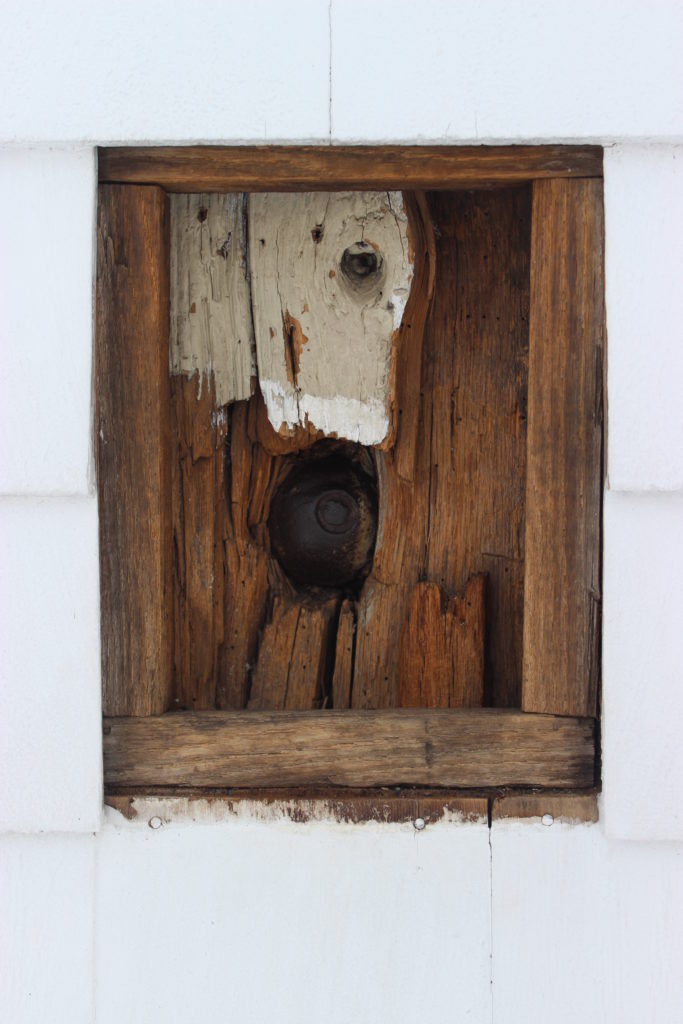
Timothy Keeler’s tavern, now a museum, drew cannon fire (a cannonball is still buried in a corner post). The British believed patriots were making ammunition in the basement. Courtesy of The Keeler Tavern Museum, Ridgefield
The town was the site of a skirmish during the Revolutionary War. On April 26, 1777 the British burned Patriot supplies in Danbury. American Patriots tried to defend Danbury but failed. The British marched south to returned to their ships in Long Island Sound. They marched down Ridgefield’s Main Street. The Patriots did not give up. Benedict Arnold and his troops chased after them but could not stop them. Today you can see a British a cannonball buried in a corner post of the Keeler Tavern Museum.
How do residents make a living?
Early residents were farmers. They grew enough food for themselves and their families. There were a few small industries including a blacksmith, and mills for grinding grain and sawing lumber.
Timothy Keeler opened a tavern in 1772. In 1783 Joshua King opened a store. In the 1820s people made carriages, furniture, shoes, and small metal items. Limestone and other minerals were mined. But there were no major rivers or streams to power mills and industry did not expand.
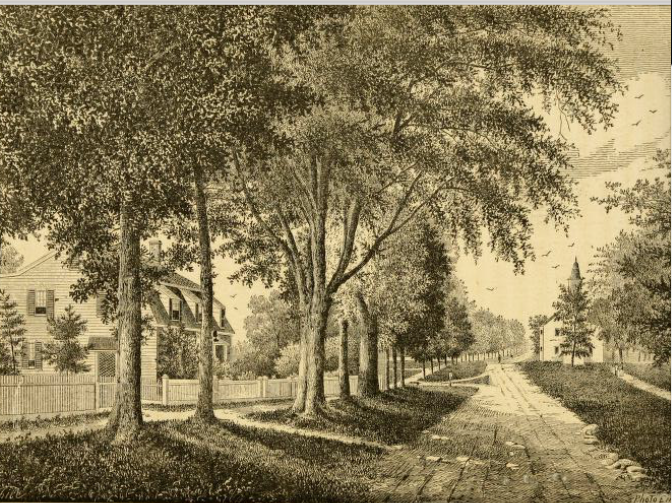
Ridgefield c. 1878 from The History of Ridgefield by Daniel W. Teller.
The railroad arrived late, in 1870. Soon after wealthy New Yorkers discovered Ridgefield. They were looking for a healthful place to escape the hot city in the summer. The quiet town with its cooler climate was a good place to build a summer home. Ridgefield became a popular summer resort. In the late 1800s immigrants from Italy came to work on the large estates and on local building projects.
During World War II, some residents worked in Bridgeport at defense plants and factories. Today, the largest company in Ridgefield is Boehringer-Ingelheim, an international pharmaceutical firm. There also are small and medium sized businesses in Ridgefield, but many people now travel to jobs outside of town.
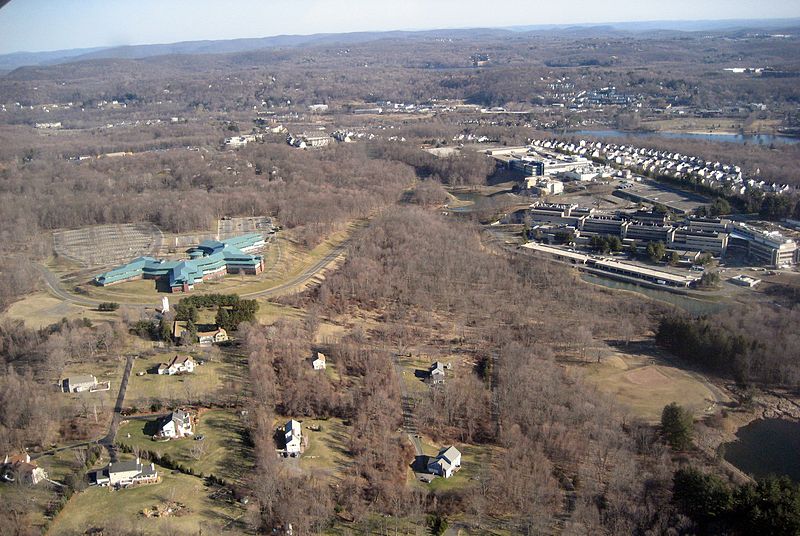
Aerial view of Ridgefield including Boehringer-Ingelheim. Wikimedia Commons
How did it grow?
At first Ridgefield grew slowly. The population barely doubled between 1790 and 1940. After World War II, Ridgefield grew rapidly. Between 1960 and 1970, it grew from 8,165 residents to 18,188! It became a good place to live and commute to jobs nearby. People worked in Danbury, southwest Connecticut, and New York. Some worked on the Hubble Space Telescope, in the computer industry, or as airline pilots. Today, around 25,000 people live in Ridgefield.
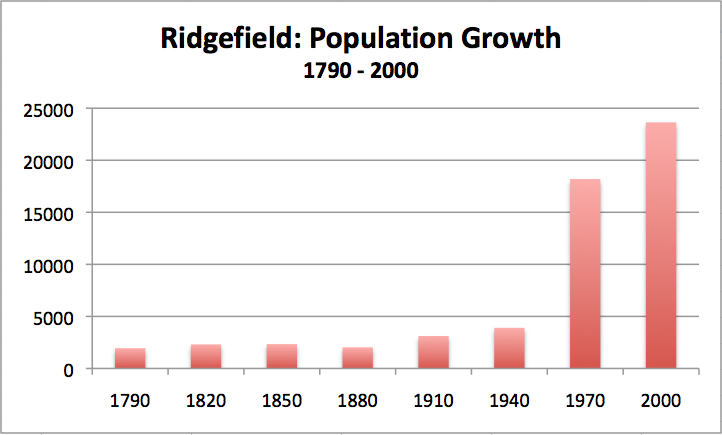
What are its notable places?
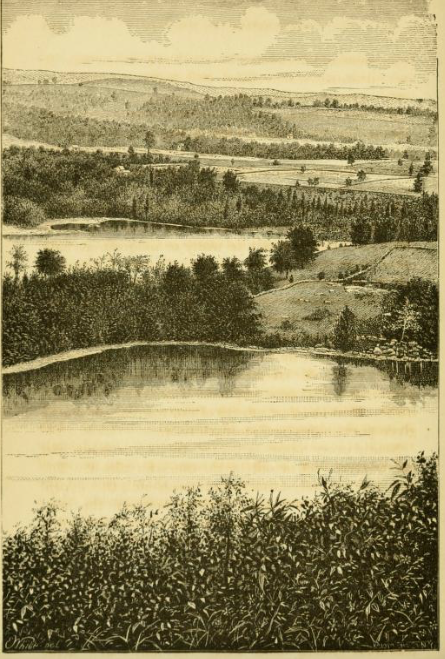
View from West Mountain, c. 1878, from The History of Ridgefield by Daniel W. Teller
Aldrich Contemporary Art Museum The museum was founded in 1964 to exhibit contemporary art.
Keeler Tavern Museum & History Center The museum tells 300 years of Ridgefield history including about the Revolutionary War Battle of Ridgefield.
Ridgefield Center Historic District This part of town is listed on the National Register of Historic Places.
Weir Farm National Historic Site J. Alden Weir was an important American Impressionist painter. His farm and studio is one of Connecticut’s two National Park sites. The park is partly in Wilton.
Who are its notable people?
Phineas Lounsbury and George Lounsbury. The two brothers were born in Ridgefield. They were both governors of Connecticut. Phineas (born in 1841, died in 1925) was governor for one term from 1887 to 1889. His older brother George (born 1838, died 1904) was governor for one term from 1899 – 1901. The brothers ran two successful shoe factories. Read more about Phineas HERE and more about George HERE.
Maurice Sendak Important children’s book author and illustrator Maurice Sendak (Where the Wild Things Are) was a longtime resident of Ridgefield. He wrote many of his books in his Ridgefield home. A section of Route 35 in town was named the Maurice Sendak Memorial Highway in his honor.
Samuel Griswold Goodrich Samuel Goodrich was born in Ridgefield in 1793. He became an important writer and publisher, especially of children’s books under the pen name Peter Parley. He attended the little red school known as the Peter Parley Schoolhouse from 1799 to 1803. He died in 1860.
Thanks to the Keeler Tavern Museum for assistance with My Town: Ridgefield.


 Ridgefield is in the southwest part of the state. It is bordered to the north and east by Danbury and Redding. Wilton is to the south. Its western border is the state border. New York State is to the west. Ridgefield is named for its rocky ridges. The highest point in town is 1,060 feet above sea level. There are mineral deposits and limestone was mined in town.
Ridgefield is in the southwest part of the state. It is bordered to the north and east by Danbury and Redding. Wilton is to the south. Its western border is the state border. New York State is to the west. Ridgefield is named for its rocky ridges. The highest point in town is 1,060 feet above sea level. There are mineral deposits and limestone was mined in town. 20,000 acres of land from Catoonah. Catoonah was sachem of the Ramapoo Indians.
20,000 acres of land from Catoonah. Catoonah was sachem of the Ramapoo Indians.



